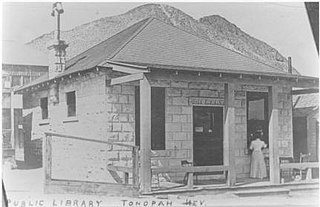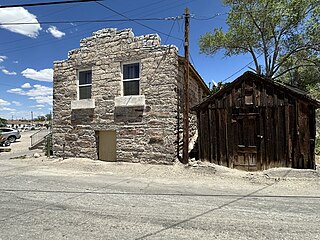
The Nye County Courthouse in Tonopah, Nevada is a two-story rusticated stone building. Its Romanesque Revival entrance and pointed dome are unique in Nevada. The courthouse was built following the move of the Nye County seat from Belmont to Tonopah in 1905.
The Samuel C. Dunham House in Tonopah, Nevada was built in 1904. It is a typical example of the houses built at the time by prosperous businessmen in Tonopah. The bungalow-style house features six tapered shingled columns supporting an expansive front porch, which curves around the corner. It was listed on the National Register of Historic Places in 1982.

The Tonopah Public Library in Tonopah, Nevada was the third public library in Nevada.The one story stone building was designed by John J. Hill and was completed in 1906. The library was established by local residents Grace R. Moore and Marjorie Moore Brown to house a gift of 200 books from George F. Weeks.

The Brokers Exchange in Tonopah, Nevada, also known as the Tonopah Divide Mining Company was built in 1905 during Tonopah's mining boom. Originally a two-story building, it housed a brokerage, real estate office, and the offices of Tonopah lawyer Patrick McCarran. A fire destroyed the upper floor in 1912. The Tonopah Divide Mining Company, controlled by George Wingfield and Cal Brougher, purchased the property for use as an office in 1919. The ruined top story was removed and the first floor was re-roofed and capped with a decorate plaster frieze.
The Nevada–California Power Company Substation and Auxiliary Power Building is an industrial building in Tonopah, Nevada. Built in 1905, it provided electricity to the town and the surrounding mine operations. The building was used by the Nevada–California Power Company, a predecessor of Southern California Edison.

The Bass Building is a historic building located at 119 St. Patrick in Tonopah, Nevada. Built in 1904, the building is the third oldest stone commercial building in Tonopah. The building has a simple stone design reflective of a transitional period between rustic and well-crafted stone buildings. A. A. Bass built the structure as a lodging house; it later served as offices for a telephone company and as a fraternal lodge. A 1912 fire gutted the building's interior, but Bass rebuilt it the following year.

The Tonopah Liquor Company Building is a historic building located on Main St. in Tonopah, Nevada. The building was constructed in 1906 by the Tonopah Liquor Company. The stone building was designed in the Classical Revival style and features a large pediment with a stone cornice. While the building was one of many stone structures built in Tonopah's early history, it is now one of only four remaining in the town; a local historic survey claimed it to be the most well-crafted of the remaining buildings.

The Water Company of Tonopah Building is a historic building located at the intersection of Burrough and Brougher Avenues in Tonopah, Nevada. Built in 1909, the building housed offices for the Water Company of Tonopah. Tonopah's first water service began in 1902, when three water companies each gained franchises to provide water to one district of the town. By 1905, Philadelphia businessman John Brock owned two of the water companies, which he consolidated into the Water Company of Tonopah. Brock also owned multiple mines in Tonopah and the local railroad. The Water Company of Tonopah Building is the only surviving building which belonged to one of Tonopah's early water companies.

The Tonopah Volunteer Firehouse and Gymnasium is a historic fire station located at the intersection of Brougher and Burro Streets in Tonopah, Nevada. Built in 1907, the firehouse housed Tonopah's volunteer fire department. The firehouse was built by Tonopah's newly appointed fire chief to address inadequacies in the town's fire protection services, which had failed to stop a major fire in 1904. A gymnasium for the firefighters was constructed next to the fire station in 1908. Tonopah still suffered three major fires after its fire station was built, including a 1920 fire which damaged the station itself; the building was subsequently restored to its original condition.
The Tonapah Extension Mining Company Power Building is a historic power plant located on Main Street in Tonopah, Nevada. The building was constructed by 1920 by the Tonopah Extension Mining Company, possibly as a replacement for a 1909 plant. The plant was built with fired brick, an unusual construction material in the area. It is the only surviving building from the Tonopah Extension Mine, a major Tonopah mine which opened in 1903.
The Nye County Mercantile Company Building is a historic building located at 147 Main St. in Tonopah, Nevada. The two-story concrete block building was constructed in 1905. While concrete blocks were a popular building material in the era, the building was one of the first in Tonopah to be built with the blocks. Businessman Henry C. Cutting built the building to house his mercantile business. Cutting opened the first mercantile business in Tonopah; he reorganized the business as the Nye County Mercantile Company when he constructed its new building.
The Verdi Lumber Company Buildings are three historic buildings on Main St. in Tonopah, Nevada. The buildings include two two-story lumber sheds, one open and one enclosed, and a storage building. The buildings were constructed in 1911, the year the Verdi Lumber Company was incorporated. A branch of the Tonopah and Goldfield Railroad connected to the site, allowing the company to transport its products. The company eventually became the largest lumber company in central Nevada. The three buildings are the only remaining buildings from the company's Tonopah facilities.

The Wieland Brewery Building is a historic building located on Mineral Street in Tonopah, Nevada. Built in 1901, the building was the first stone building constructed in Tonopah. It was also one of the first permanent buildings built in the town, which was still primarily a mining camp at the time. The building had several owners in its early years. It was apparently first owned by H.C. Brougher, but businessman Harry King bought the brewery by the end of 1901. King sold the brewery to two other businessmen in the spring 1902 but purchased it again by the following October. At the end of 1902, King added a crafted parapet to the building, which indicates that Tonopah had local stone craftsmen by that time.
The Board and Batten Cottage is a board and batten house located on Prospect Street in Tonopah, Nevada. The house was built in 1909. Its design features a T-shaped plan with symmetrical features, a hipped roof, and molded and boxed cornices along the roof line. The house originally had two porches, including one along the entire front of the building, but both have been removed. Board and batten homes were common in early Tonopah, and the house is a relatively intact example of the style.

The Tonopah Main Post Office, also known as US Post Office–Tonopah Main, is the main post office in Tonopah, Nevada. Built in 1941, the post office was the first and only federally constructed post office in the city. The post office was designed in a Starved Classical style typical of federal buildings of the era. The government began planning the post office in 1937, and its site was chosen in 1940. The building's cornerstone was laid in May 1941; a civic ceremony and parade marked the occasion. The post office opened for business on December 7, 1941, the same day as the attack on Pearl Harbor. In addition to serving as Tonopah's post office, the building also houses government offices in its basement.

The Cal Shaw Adobe Duplex is an adobe house located at 129 Central Street in Tonopah, Nevada. The house, which was built in 1905, is typical of the adobe homes commonly built in Tonopah in the early 1900s. The building's exterior is scored to resemble stone; the home's design also features a decorative frieze and a porch supported by turned columns. The home has changed little since its construction and has been called "the best preserved adobe residence in Tonopah" by a local historic survey.

The Stone Jail Building and Row House are two adjacent stone buildings located on Water Street in Tonopah, Nevada. The jail was built in 1903 and the adjacent row house in 1908. Both building were at one time used as a brothel. The buildings were added to the National Register of Historic Places in 1982.

The Brann Boardinghouse is a historic boarding house located on Bryan Street in Tonopah, Nevada. The 2+1⁄2-story building is the largest wood-frame residence in Tonopah. The building's design includes a two-story porch with a balustrade along the second floor, molded cornices, boxed eaves, and a hipped roof; the inside has 18 rooms connected by two central hallways, one on each floor. Mrs. A.J. Brann built the boarding house in 1906. It was one of many boarding houses built in Tonopah to house the community's miners. The house is now one of only four boarding houses remaining in Tonopah.
The Dr. J. R. Masterson House, at Ohio Ave. and 2nd St. in Tonopah, Nevada, is a 35-by-35-foot stone and frame historic building that was built in 1908. It has also been known as the Fred Chapman House. It was built as a residence and later served as a rooming house for most of its existence. It was a work of James Golden. It was listed on the National Register of Historic Places in 1982.

The Frank Golden Block, at Brougher and Main Sts. in Tonopah, Nevada is a historic building that was built in 1902. It was listed on the National Register of Historic Places in 1982.















